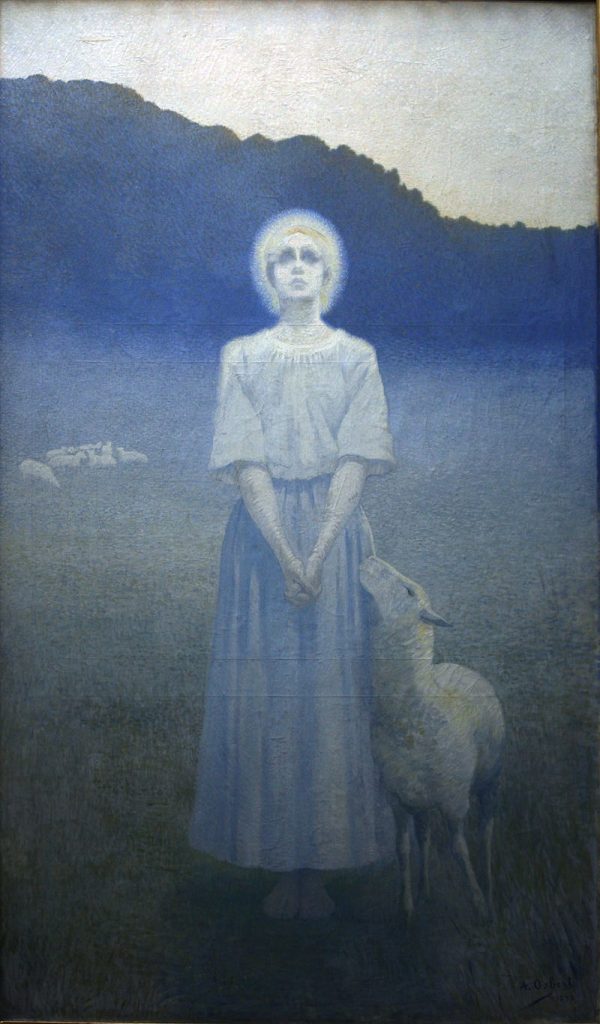
Vision de Sainte Geneviève” by Alphonse Osbert is a masterful painting that captures the mystical and spiritual essence of Saint Genevieve, the patron saint of Paris. Alphonse Osbert (1857–1939) was a French Symbolist painter who, during his career, moved away from the naturalistic depictions common in the 19th century to embrace a more symbolist approach to art. This transition is vividly reflected in “Vision de Sainte Geneviève,” where Osbert explores themes of spirituality, divinity, and the mystical experiences of the saint.
Historical Background and Context
Born in 1857, Alphonse Osbert began his artistic career influenced by the naturalism and realism prevalent in the art world of the time. However, as his style evolved, he became increasingly drawn to the Symbolist movement. This movement, a reaction against the naturalistic depiction of realism and the external world, focused on representing the internal experiences—emotions, feelings, and ideas—through art. Symbolists often used mythological and dreamlike imagery to explore these themes. Osbert’s fascination with medieval themes and saints, particularly Saint Genevieve, is a reflection of this symbolic and mystical exploration.
Saint Genevieve herself was an iconic figure in French history and spirituality. Born in Nanterre, France, around 419-422 AD, she became renowned for her piety, devotion, and, according to legend, miraculous interventions that saved Paris on multiple occasions. Her visions, prophetic abilities, and determined spirit made her a revered figure, and she was later canonized as the patron saint of Paris.
The Painting
“Vision de Sainte Geneviève” is not just a portrait but a symbolic representation of the saint’s spiritual experiences and visions. Osbert’s choice to depict Genevieve in a moment of mystical vision rather than a literal historical context highlights the symbolic and introspective nature of his art.
Artistic Style and Symbolism
Osbert’s style in this painting is characterized by soft, ethereal lighting, muted colors, and a dreamlike atmosphere that seems to transcend time and place. This approach is emblematic of the Symbolist movement, which sought to express the ineffable; those aspects of human experience that go beyond the physical world. The painting likely utilizes a composition that guides the viewer’s eye towards Genevieve, possibly illuminated or highlighted to symbolize her divine inspiration or revelation.
The use of light and color in Osbert’s painting could be particularly notable, with a possible emphasis on blues and violets to create a serene, contemplative atmosphere. These choices might reflect the spiritual purity and the heavenly nature of Genevieve’s visions. Additionally, symbolic elements such as religious iconography, nature, or abstract motifs might be present to underscore the saint’s connection to the divine and the natural world.
Impact and Legacy
“Vision de Sainte Geneviève” contributed to the revival of interest in medieval spirituality and mysticism during the late 19th and early 20th centuries. Osbert’s work, along with that of other Symbolists, challenged the prevailing artistic norms of his time, paving the way for future movements that would continue to explore the symbolic and emotional potential of art.
In the broader context of Osbert’s oeuvre, “Vision de Sainte Geneviève” exemplifies his mature style, in which he fully embraces Symbolism to convey profound spiritual and emotional depths. This painting, through its symbolic representation of Saint Genevieve, invites viewers to reflect on themes of faith, divine inspiration, and the power of spiritual visions.
Conclusion
Alphonse Osbert’s “Vision de Sainte Geneviève” stands as a testament to the Symbolist movement’s exploration of spirituality, emotion, and the inner world through art. In depicting the mystical experiences of Saint Geneviève, Osbert invites us to consider the deeper, often unseen forces that shape our lives and beliefs. The painting not only honors the legacy of the patron saint of Paris but also challenges us to perceive beyond the visible, into the realms of the spiritual and the symbolic.
While the exact details of “Vision de Sainte Geneviève” are subject to the interpretations and available resources on Osbert’s work, the painting’s significance in the context of Symbolist art and its reflection of mystical and spiritual themes remain clear. Through this work, Osbert contributes to the rich tapestry of artistic exploration into the nature of human experience, spirituality, and the divine.
Given the constraints of not inventing details and adhering closely to verified knowledge, this overview provides a thematic and stylistic analysis of “Vision de Sainte Geneviève” within Alphonse Osbert’s career and the broader Symbolist movement. The painting, embodying the mystical and spiritual search that defines much of Symbolist art, continues to resonate with audiences today, inviting contemplation and reflection on the deeper meanings that lie beyond the surface of our visual and temporal world.





